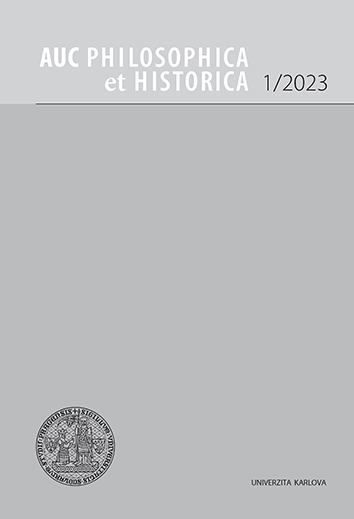AUC Philosophica et Historica je víceoborový akademický časopis zaměřený na humanitní a společenskovědné obory (filozofie, psychologie, pedagogika, sociologie, obecné, české a hospodářské dějiny, pomocné vědy historické a archivnictví, etnologie).
Časopis je indexován v databázích CEEOL, DOAJ a EBSCO.
AUC PHILOSOPHICA ET HISTORICA, Vol 2018 No 2 (2018), 77–99
Alcohol use by youth in the Czech Republic and Finland: An empirical test of skog’s theory of the distribution of alcohol consumption
Iveta Čermáková, Zuzana Podaná
DOI: https://doi.org/10.14712/24647055.2018.5
zveřejněno: 18. 04. 2018
Abstract
This article focuses on alcohol consumption among Czech and Finnish youth. First, it describes the situation regarding alcohol consumption in both countries, including trends in consumption in recent years, and, second, it presents and tests the theory of the distribution of alcohol consumption by a Norwegian sociologist Ole-Jørgen Skog, which has had an influence on many alcohol policies. Skog’s theory describes the relationship between mean alcohol consumption in a population and the consumption at all levels of consumption (from light to heavy drinkers) and suggests that they are strongly interconnected and are of log-linear nature. Data used in this study come from two large-scale international surveys the “European School Survey Project on Alcohol and Other Drugs” and the “International Self-Report Delinquency” study and cover the period from 2003 to 2013. Results show that alcohol consumption among Finnish juveniles is considerably lower compared to their Czech peers and, moreover, it seems to gradually decrease in the given time period, again, unlike Czech youth. Results concerning the test of Skog’s theory are largely consistent with his propositions. The only difference is revealed, specifically it is the group of heavy drinkers – not light drinkers as in Skog’s study – which is most affected by changes in mean alcohol consumption in the population.
klíčová slova: youth; alcohol; Skog’s theory; Czech Republic; Finland
reference (19)
1. Bjarnason, T. (2006). Polarization in alcohol consumption among Icelandic adolescents, 1995–2003. Nordic Studies On Alcohol And Drugs, 23, 51–58. CrossRef
2. Brunborg, G. S., Bye, E. K., & Rossow, I. (2014). Collectivity of drinking behavior among adolescents: An analysis of the Norwegian ESPAD data 1995–2011. Nordic Studies On Alcohol, 31(4), 389–400. CrossRef
3. Chomynová, P., Csémy, L., & Mravčík, V. (2016). Evropská školní studie o alkoholu a jiných drogách (ESPAD) 2015. Zaostřeno, 2(5), 1–16. Retrieved from https://www.drogy-info.cz/data/obj_files/32196/734/zaostreno_2016-05_v03.pdf
4. Csémy, L., Lejčková, P., Sadílek, P., & Sovinová, H. (2006). Evropská školní studie o alkoholu a jiných drogách 2003. Praha: Úřad vlády ČR. Retrieved from http://www.drogy-info.cz/data/obj_files/1665/361/espad_web.pdf
5. Čermáková, I. (2016). Konzumace alkoholu mládeží: testování Skogovy teorie distribuce alkoholové konzumace. Diplomová práce. Praha: Filozofická fakulta Univerzity Karlovy.
6. Gmel, G., & Rehm, J. (2000). The empirical testability of Skog's theory of collective drinking behaviour. Drug and Alcohol Review, 19(4), 391–399. CrossRef
7. Hibell, B., Guttormsson, U., Ahlström, S., Balakireva, O., Bjarnason, T., Kokkevi, A., & Kraus, L. (2012). The 2011 ESPAD Report. Substance Use Among Students in 36 European Countries. Stockholm: The Swedish Council for Information on Alcohol and other Drugs. Retrieved from http://www.espad.org/uploads/espad_reports/2011/the_2011_espad_report_full_2012_10_29.pdf
8. Hallgren, M., Leifman, H., & Andreasson, S. (2012). Drinking Less But Greater Harm: Could Polarized Drinking Habits Explain the Divergence Between Alcohol Consumption and Harms among Youth? Alcohol And Alcoholism, 47(5), 581–590. CrossRef
9. ISRD3 Working Group (2013). Questionnaire ISRD3: Standard Student Questionnaire (ISRD3 Technical Report Series #2). Boston, MA: Northeastern University, School of Criminology and Criminal Justice.
10. Junger-Tas, J., Marshall, I. H., Enzmann, D., Killias, M., Steketee, M., & Gruszczynska, B. (2010). Juvenile delinquency in Europe and beyond. New York: Springer. CrossRef
11. Kraus, L. et al. (2016). ESPAD Report 2015. Results from the European School Survey Project on Alcohol and Other Drugs. Luxembourg: Publications Office of the European Union. Retrieved from http:// www.espad.org/sites/espad.org/files/TD0116475ENN.pdf
12. Kubička, L., Csémy, L., Duplinský, J., & Kožený, J. (1998). Czech men's drinking in changing political climates 1983–93: a three wave longitudinal study. Addiction, 93(8), 1219–1230. CrossRef
13. Livingston, M. (2008). Recent trends in risky alcohol consumption and related harm among young people in Victoria, Australia. Australian & New Zealand Journal Of Public Health, 32(3), 266–271. CrossRef
14. Meier, P. (2010). Polarized drinking patterns and alcohol deregulation. Nordic Studies On Alcohol And Drugs, 27(5), 383–408. CrossRef
15. Moravcová, E., Podaná, Z., & Buriánek, J. (2015). Delikvence mládeže: trendy a souvislosti. Praha: Triton.
16. Norström, T., & Svensson, J. (2014). The declining trend in Swedish youth drinking: collectivity or polarization? Addiction, 109(9), 1437–1446. CrossRef
17. Rossow, I., Mäkelä, P., & Kerr, W. (2014). The collectivity of changes in alcohol consumption revisited. Addiction, 109(9), 1447–1455. CrossRef
18. Skog, O. J. (1985). The Collectivity of Drinking Cultures: A Theory of the Distribution of Alcohol Consumption. British Journal Of Addiction, 80(1), 83–99. CrossRef
19. World Health Organization. (2014). Global status report on alcohol and health 2014. Geneva, World Health Organization. Retrieved from http://apps.who.int/iris/bitstream/10665/112736/1/9789240692763_eng.pdf?ua=1

Alcohol use by youth in the Czech Republic and Finland: An empirical test of skog’s theory of the distribution of alcohol consumption is licensed under a Creative Commons Attribution 4.0 International License.
